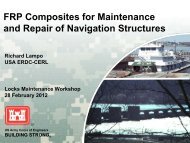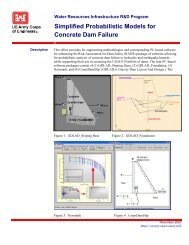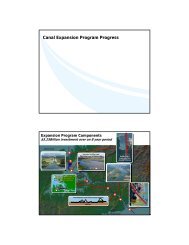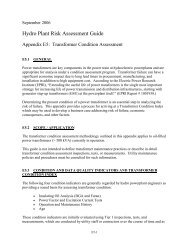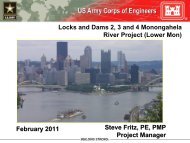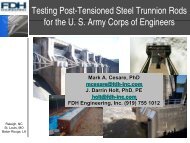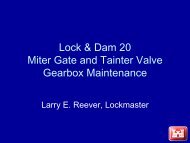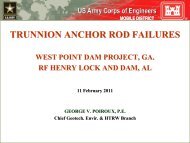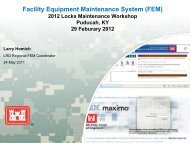You also want an ePaper? Increase the reach of your titles
YUMPU automatically turns print PDFs into web optimized ePapers that Google loves.
<strong>CHICAGO</strong> <strong>HARBOR</strong> <strong>LOCK</strong> <strong>GATES</strong>Replacement, Lessons Learned, Repairs & SuccessesRobert (Bob) OjalaChicago District NavigationStructures ManagerChicago District Office12 February 2013US <strong>Army</strong> Corps of EngineersBUILDING STRONG ®
Flood Risk – Backflow through Lock GatesJuly 2010 Rain Event• 7 inches of rain fell in 12 hours when 3 inches was forecasted• Top of the lock wall is +7’0”. The water nearly hit +5’0” and HPUs were wetted• The Lock Gates were opened and the river was allowed to drain into LakeMichigan to keep the city from flooding.• Along with carrying rainwater out into the Lake, the river also has the potentialto carry sewage with it.• This event did cause minimal flooding in low lying structures within the cityincluding the train station and condo building basements• ONLY Two weeks after the event a failure and emergency repairs shut the lockdown – if these events coincide, the City could experience catastrophic floodingBUILDING STRONG ®
Flood Risk – Backflow through Lock GatesBUILDING STRONG ®
Flood Risk – Backflowthrough Lock Gates• The Chicago Lock is used forflood control and navigation• The Lock can be closed totraffic during the winter withouta large impacts (Barges, Fire& Police Boats)• If a large rain event or snowthaw occurs, the gates mustbe opened, regardless of theimpact on construction• The Contractor in 2010 wason call 24 hours a day shouldthe stop logs need removal7BUILDING STRONG ®
Original Sector Gate Design• Characteristics► Built and installed in 1936► Constructed of a series of 6 horizontal frames.► Constructed using 36ksi plate and W-sections riveted together► Each gate leaf weighed 265,000 lbs• Operation► The old sector gates pivoted on a non-adjustable upper hinge and lowerpintle ball. The gate leafs were also supported on two pairs of rollerswhich rode on a lower track.► 4 point contact was maintained through the entire range of motion► Operated by pulling on a hinge strut arm that slid into recess on a track► Operation was by high voltage electric motors► Great idea on paper – maintenance difficulties over timeBUILDING STRONG ®
Sector Gate Strut ArmBUILDING STRONG ®
Original Sector Gate Condition• The original sector gates hadsustained quite a bit of damageand corrosion over their 75 yearlife span10BUILDING STRONG ®
The Need for new Sector Gates• Old gates in poor condition with extensive corrosion• Water diversion through lock due to incomplete seal closure• Maintaining contact & operation of the lower and upper tracks wasbecoming increasingly difficult and costly• Debris on the track or roller damage required divers which can take days• If something got stuck on the track or the bushings failed, the gates couldnot be opened in an emergency and a key flood control device was notoperational11BUILDING STRONG ®
Lock Gate Replacement Project01 NOVEMBER 2010 – 15 APRIL 2011• Original Gates from 1938 still installed• Chicago Sanitary District operation until 1985• Project originally planned for only two gates• ARRA Funding changed project to four gates• Old plans used, with no time to improve design• No improvements to controls were in the plans• Many small oversights????BUILDING STRONG ®
New Sector Gate Design• Layout• 3 Horizontal Frames, Curved Skin Plate, two vertical K-brace frames at thelock chamber and recess sides• 50 KSI steel fully welded; not riveted or bolted except for hinges & racks• Designed per AISC LRFD design and computer modeled with StaadPro• Designed between 2001 and 2003 in accordance with Corp Ems• Used Greased Bronze Bushing instead of greaseless bushing• Operation• Supported by pintle and upper hinge• Operated by skin plate mounted rack and pinion gear• New hydraulic HPUs replaced the electric motors• Lock Gate walkways able to support BobCat and heavy loads13BUILDING STRONG ®
New Sector Gate Design14BUILDING STRONG ®
Stop Log Storage ProblemsBUILDING STRONG ®
Poor Blocking Design UsedBUILDING STRONG ®
Storage Site Under WaterBUILDING STRONG ®
Moving Stop Logs to LockBUILDING STRONG ®
Preliminary Weld Inspection inDansville, NYBUILDING STRONG ®
Gate FabricationSkin Plate Fabrication Jig20BUILDING STRONG ®
Test fitting FenderAssembliesTest fitting WalkwayAssemblies21BUILDING STRONG ®
Gates Erected in ChicagoBUILDING STRONG ®
Completing Gates at Chicago SiteBUILDING STRONG ®
Welding Lessons Learned: Sector Gate QA vs. QC• Per contract, the fabricator, LMC hired a QC firm to test and inspect all the fracturecritical welds.• The General Contractor hired their own QA to verify the fabricator’s QC before“buying” the gates.• There were a lot of discrepancies between the fabricator’s QC and the contractor’sQC.• USACE had originally planned to hire QA to check 5% of the welds on the gates.• Due to the discrepancies and the inability of the GC to rectify the differences betweentheir own QA and the fabricator’s QC, we expanded the scope of our QA.• Our QA’s new scope grew to include 100% visual inspection and 50% NDT on allfracture critical members.• In two days the weld inspector was able to completely assess all four gates.• For a minimal expense, we gained a much greater confidence in the final product.• If we could do it again, we would have involved our weld inspector earlier in theprocess to reduce the lost time due to conflicting QC/QA reports and due to having torepaint areas of each gateBUILDING STRONG ®
Pintle Built-up section size inconsistenciesMismatched Member flanges25BUILDING STRONG ®
Solution DevisedDuring AssemblyBUILDING STRONG ®
Poor Fit-Up & AlignmentBUILDING STRONG ®
Moving Gates Into Position forLoading onto BargeBUILDING STRONG ®
Lake Move of Gates Required Fair Weather PermitBUILDING STRONG ®
Stop Logs Delivered to LockBUILDING STRONG ®
New Lock Gates DeliveredBUILDING STRONG ®
Two Gates Stored in Parking LotBUILDING STRONG ®
Lock Gate Installation• Removal and installation of all 4 gates performed during one 6.5month winter shut-down period.01 NOVEMBER 2010 – 15 APRIL 2011• The Construction schedule was very compressed and necessitatedworking 10 hours days, 6 or 7 days a week.• If a reverse back flow event occurred, the bulkheads would have tobe removed and the gate blocks re-watered regardless ofconstruction impactBUILDING STRONG ®
Demolition BeginsBUILDING STRONG ®
Gate Installation: Installation in two pieces• The decision to retain the existing hingeplates created some installationchallenges• The solution was to separate the upperhinge from the gate and to install thegate only on the pintle and temporaryblocking• The upper hinges and fabricated fillerplates were installed afterwards• Following bolt up, all cut members werewelded and fully UTedGate without upper hingeBUILDING STRONG ®
Gate InstallationNew Gate without Upper Hinge in Place36BUILDING STRONG ®
Upper Hinge InstallationUpper Hinge installed with temporarysupports cut37BUILDING STRONG ®
New Gates InstalledBUILDING STRONG ®
New Seals Being InstalledBUILDING STRONG ®
Operating Machinery InstalledBUILDING STRONG ®
Flooding After Gates InstalledBUILDING STRONG ®
Project Status as of 15 April 2011• The Project was completed on time and under budget• All 4 sector gates are installed and fully operational• Considering relocating the HPUs further away from the gates toalleviate the pitchline overlap and potential for gate binding• The project was nominated for an LRD excellence awardBUILDING STRONG ®
Problems Develop During Operations• Mechanical limit switch failures (17/24)• Brake failures during back-flow event• Control relays & Touch Screen problems• Bottom seal squeak & shudder• Hinge & pintle noise• Numerous and large leaks on HPUs• Damage to HPU Pinion shaft during HotWeatherBUILDING STRONG ®
Poor Tooth Contact PatternDiscoveredBUILDING STRONG ®
Lessons Learned - Rack Installation• Dykem Fluid test to determine points of contactMinimal ContactFull Contact45BUILDING STRONG ®
Lessons Learned - Rack InstallationFull Contact at center ofrack toothMinimal Contact at topof rack toothThis rack misalignment will cause:•Variable/ Premature wear•Rounding of Pinion Teeth•Potential for gate binding46BUILDING STRONG ®
Lessons Learned - Rack Installation• Large variation in individual rack section installationRacks not level, plumb, or well aligned at joints47BUILDING STRONG ®
Lessons Learned - Rack Installation• Large variation in rack pitch48BUILDING STRONG ®
Lessons Learned - Rack Installation• The plans and specs should have required that field drilling andinstallation of racks was required. Slotting the holes for fieldadjustability was also necessary at the worst areas(Louisville Crew made these repairs)• Our plans should have specified a tolerance over the entire length ofthe rack, not just individual sections• Specs should have required a dye test be performed as aperformance test before accepting the gates49BUILDING STRONG ®
Louisville Crew Working inJanuary Chicago WeatherBUILDING STRONG ®
Lessons Learned – HPU Installation/ Pitch-lineSeparationPinion and Rack interfaceBUILDING STRONG ®
Original Pitch Line SeparationBUILDING STRONG ®
Lessons Learned – HPU Installation/ PitchlineSeparation in HOT WEATHER• Per our plans and specsthese pitch lines are tocoincide at 140 degreesPinionGearPitch-lineRack GearPitch-lineOverlap• The pitch lines were pastoverlapping at 80 degreesambient temperature andlow water temperature• Temperatures reached 97degrees during the summerof 2011 in Chicago• Potential for Binding!BUILDING STRONG ®
Rigged Cooling System toRelieve Heat ExpansionReduced Radiant heating of structure from 127 deg. in 97 deg.ambient to less than 80 deg. using PVC water soaking system.BUILDING STRONG ®
Damage to Pinion Gear ShaftDiscovered During High TemperaturesBUILDING STRONG ®
Shaft Weld Broken & Bolts LooseBUILDING STRONG ®
Visit to Calcacieux Lock, Louisiana -Greater Pitch Line Separation NotedBUILDING STRONG ®
Repetitive, Large Oil LeaksBUILDING STRONG ®
Hose & Fitting VariationsBetween the four HPUsBUILDING STRONG ®
HPUs Modified to have LowerProfile and Identical HosesBUILDING STRONG ®
Limit Switch FailuresBUILDING STRONG ®
Bent Mounting Brackets andBroken Limit Switches ResultedLimit Switches hung on walkwaystructure, causing unwanted movement.BUILDING STRONG ®
Thermal expansion Caused Racking of LockGate Structure and Walkway SupportsLimit Switches struck by Target, and17 of 24 switches failed in first seasonBUILDING STRONG ®
Conversion to Proximity SwitchesBUILDING STRONG ®
Eliminated Physical ContactBUILDING STRONG ®
Bottom Seal Too Tight whenStructure Racked in Hot WeatherBUILDING STRONG ®
Divers removed the vertical legof the stainless angle to reducepressure on the bottom sealsBUILDING STRONG ®
Lower Seal Stainless Angle Iron showed severepitting and corrosion after less than one year ofservice.BUILDING STRONG ®
PLC Controls are Actually usedto turn old controls OFF & ONand need to be updated toeliminate problematic failures oftimers and relays left over fromthe old system.BUILDING STRONG ®
Walkway Pinch Points around GatesDiscovered During ConstructionBUILDING STRONG ®
Access Pinch Points Created#1 – Contractor made partial repair#3 Moved Railing#4 - Removedobsolete building#2 – Problem remainsBUILDING STRONG ®
Icing in Old Lock GatesEliminated by High Volume Bubbler SystemBUILDING STRONG ®
New Bubbler System Installed• Air compressors areindoor units, installedoutdoors, resulting inoil temperatureproblems, rusting, etc.Plans in process tobuild a heatedenclosure for them.• Piping system wasover-complicated forthis application, using12 remotely operatedvalves for each of thetwo compressors.Plans to simplify thepiping whenenclosure is built.BUILDING STRONG ®
Improved Stop Log Storage toEliminate Standing WaterBUILDING STRONG ®
Improved Blocking for Stop LogStorage, Where NeededBUILDING STRONG ®
General Lessons Learned• Operations must be involved earlier in theDesign Process• Better Weld Inspection required• Better design of controls and betterelectrical inspection required fromConstruction• Consult with other similar Locks (don’t tryto reinvent the wheel)BUILDING STRONG ®
Future Problems???Emergency Operations Adequate?Pintle Greasing Adequate?BUILDING STRONG ®
Any Questions?78BUILDING STRONG ®




